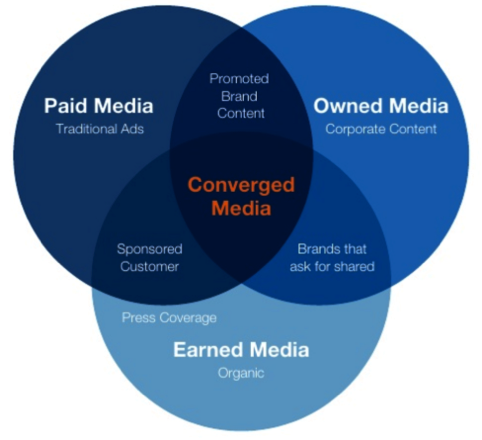There seems to be a constant debate over achieving the perfect balance of creating quality content to share on social media, while maintaining the right quantity of that content to continually reach your audience without sacrificing quality.
It’s entirely possible to achieve this balanced approach to creating social media content by slowly scaling your efforts to reach your social media followers on a regular basis with messaging that’s valuable to them, related to your brand and drives results for your business.
Often organizations focus on getting a larger audience on social media for the sake of getting a larger audience, but this shouldn’t be the main reason you’re scaling your content to the next level.
The main reason is that the digital landscape is noisy and more difficult than ever for your content to get seen as it competes with all the other messaging from other companies in your industry.
It will only get more difficult to get your messaging across to the right people every day with the introduction of new platforms and more organizations using them, which is why it’s critical for your company to continue to slowly scale your content to remain a relevant voice for your audience.
What matters most when scaling your social content to the next level is that you’ve got a concise plan, you remain agile throughout the process, that you always remain human with your approach and that you’ve established benchmarks for this growth.
Take the following steps to begin appropriately scaling your company’s social media content.
Develop a Concise Strategy with Consistent Timing, Post Structure, and Series
Start by creating a concise plan that is structured around the goals of your organization when it comes to actively communicating with your audience across channels. It becomes easiest to continue to grow your existing efforts on social media when you’ve identified some key processes that your organization can rely on and your audience can come to expect.
Begin by creating a consistent schedule based on an editorial calendar of when you’ll be creating, optimizing, and then sharing certain types of content and on what channels.
Once you’ve developed a baseline for your content with this calendar, it’ll be much easier to understand what sharing more content will involve in the future since you’ll have a clear vision of what you’re doing now and what resources, staff and time it takes to produce results at the current quality and quantity.

(Source: Andrew Macarthy)
The calendar will help inform your strategy for sharing content and from the content shared, you’ll be able to see what’s working and what isn’t working in terms of the type, frequency, and quality of content.
This is where being agile comes into play since you’ll consistently need to alter your content calendar to reflect what your audience is responding to or not. Experiment with different methods of posting content on Facebook, Twitter, Instagram and any other channels you’re active on to see what’s the best way to drive results from your particular audience. Listen to what your audience has to say, they might have the next great idea for your business to try.
When crafting your strategy, think similarly to how a TV network would when putting together a schedule of its programming. Your content should be consistently delivered to your audience in series based on different topics related to your business and of interest to your customer base.
For example, posting about the best fan submitted photos on every Wednesday is one type of series a business could implement across their social channels.
By creating a calendar that lays out the different aspects of your campaign as well as series that will actively address the various interests of your audience, you’ll have a strong baseline to start from to slowly add more relevant content and increase the scale of your messaging.
Use Appropriate Tools to Scale
With a concise plan in place backed by a strong bank of topics to cover in the form of series, it’s now important to match your business with the right toolkit to execute against these ideas as you continue to scale.
Selecting the right tools is important for your business to be able increase how much content you’re producing and publishing on a regular basis, since there are limits to how much your team can do in a day.
Automating some of the more repetitive processes that are involved with publishing on social is the first step to saving time and resources to spend on growing your efforts.
Focus on using a few tools that help your business grow your social presence in terms of:
- How you’re scheduling content
- Engaging with your customers
- The process for measuring your content
There are some tools that help automate all or most of these social media related processes, but it’s best to find out which combination of tools works best for your business when it comes to achieving results at the lowest cost to your business.
For scheduling your social media content on a greater scale use tools like Sprout Social, HootSuite, and Buffer to help make the daily publishing on your various channels active, leaving more time to strategize and analyze on which content will perform best on which platforms.
When it comes to engaging with customers on a regular basis in terms of monitoring feedback, providing customer service and supporting fan engagement, try using tools like Conversocial and again, Sprout Social and HootSuite.
All of these tools help bring any conversations about your business or your industry to your attention so they can quickly be dealt with to give your team more time to focus on other initiatives related to scaling your content.
For the record, don’t ever rely too heavily on tools to schedule your social media for your organization. Tools are helpful at saving time and resources, but be careful not to over schedule, over automate or forget to pay attention to the unique nuances of each social channel. At times, it’s best to use the social network itself to manage your experience on the platform to get the most far-reaching results.
Measuring your social media to see what’s working as you’re scaling is critical to continue the content series that work, while discontinuing what isn’t working as quickly as possible.
We’re a little bias here, since SumAll is a what we live and breathe everyday to bring business owners and marketers the best measurement tool for keeping track of their social media, as well as their e-mail, ads, payments, and e-commerce data.
Syncing all of your data into one concise and actionable dashboard in SumAll will go along ways towards building your social content to the next level as your team better understand how this growth in social content impacts the rest of your organization.
Focus on Adding Paid Advertising to the Mix
In a sense, paid advertising is a tool to help scale your social media content to the next level as well but with a goal of reaching a new and much larger audience than you’d typically be able to organically.
With the major changes to the Facebook’s news feed and the constant increase of messaging on all other social platforms, it’s difficult to scale to your social content to a larger audience without also continually applying your budget to pay for reach on Facebook, Twitter, YouTube or any other social platform that make sense for your business.
Used paid advertising as one approach to your social media marketing mix to help scale your best organic content, while also creating paid specific content to be shared with a healthy balance of your existing fans, customer base, and potential customers.

(Source: Smart Insights)
To continue to scale social, coordinate your organic or owned efforts with your paid media to achieve earned media, which is a third audience reached as a result of the content your organization paid to get a greater distribution.
Partner with Influencers
Another extremely important way to continue to scale your content is to have your organization partner with influencers on social media. An influencer is a person on social media that consistently creates content for their typically large and very engaged audience on a regular basis.
By partnering with influencers, you’ll be able to gain greater visibility for your content, a strong association with a recognized voice in your industry, exposure to a relevant audience, an increased following, and relevant traffic driven to your web properties.

For example, Urban Outfitters partnered with the musical group Temples by creating a blog post about them and sharing this content on Twitter with their audience with the hopes of reaching the band’s audience as well.
Match your organization with influencers in the industry that consistently shares and discusses content related to your industry, your business offerings and the interests of your customers. It’s really important that these influencers are fit to represent your business or the partnership may come off as forced.
Work with partners to share your content, co-create content with them as a participant, sponsor their activities online and ensure they bring value to your audience and their own. When you’ve taken the time to craft a genuine plan of action with an influencer or a group of influencers, you’ll be able to take your content to more relevant social media users than your business was previously able to reach.
What’s your most successful technique for scaling your social media content to a larger audience with more quality social content? What hasn’t worked to help improve the publishing of more social content for your business? Share your thoughts in the comments.
Editor’s note: This story originally appeared on SumAll’s blog.




